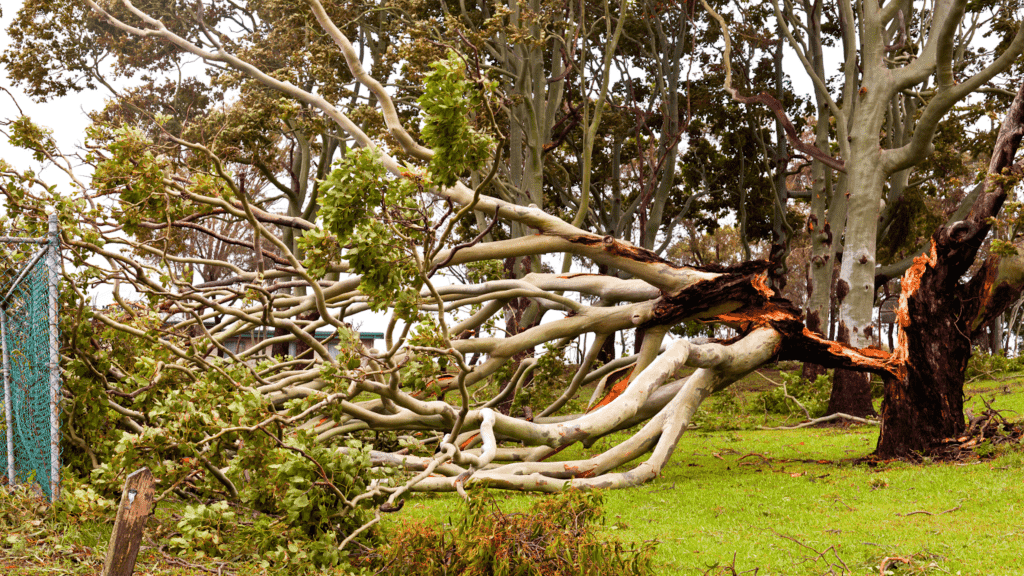Storms can damage trees, windows, doors, wires, and sometimes the roof of a house. While you may find it fairly simple to repair the parts of your house, you may not be sure of how to save a damaged tree.
Actions to repair storm-damaged trees depend on how much your trees are damaged and what damage has occurred. If the damage is too much, it may be impossible to repair and keep the tree. If the tree can be saved, you can clean the broken branches, clear the limbs, prune tree gaps with filler or organic paint, and put the split part together with a metal rod.

What Are the First Things to Do When a Storm Damages a Tree?
When a storm occurs and damages a tree, you should take immediate action after you notice a storm-damaged tree.
- First, you have to find out the areas that have been damaged. It is also necessary to see what kind of damage has occurred there. Suppose the tree has been uprooted, and in that case, you can’t repair it back.
- Next, you should bring a tree first aid kit if you have one to prevent further damage to the tree. But you must first aid the tree only after ensuring that you can save it and the tree can get over the storm damage.
- You must call a certified arborist tree service nearby your location to have professional help to save the damaged tree in your yard.
- Book an appointment fast so that the team can come and take the necessary steps to repair the tree. Please remember that considering the fact if you can repair it by yourself or not is important.
Things to Do in Response to Tree Damage
As mentioned before, you should take immediate action once you know you have to save the tree. Let’s see some methods applied to save and repair a storm-damaged tree.
Clear out Broken Limbs
Check the limbs if they have the condition to be repaired or not. It is good to prune the broken limb back into the tree for its growth. But a tree can survive without a limb if it’s too old and big enough.
In case you need to clear the broken limb, it is possible, but be careful while doing that. You should not hurt the tree trunk while cleaning the broken branches or limbs out of the damaged one. Once you have cleared the broken and unnecessary limbs from the tree, it will have less risk of death.
Consult a Certified Arborist
It is essential to consult a certified arborist to know the actual state of the damaged tree. Once you show or describe the current situation of the damaged tree, an expert arborist can suggest what to do next.
If needed, you can attach a wire, rod, or metal sprinter to hold the damaged part together. Moreover, he can suggest you prune the wounds or remove the tree if the damage is more than 50%. However, ensure the arborist is certified because tree repair success depends a lot on the skillsets of the hired professional.
Prune Trees
You must clean the wounds first to remove the damaged tree’s extra particles. Your next target should be filling the gaps with paint; of course, it has to be friendly with tree trunks. In that case, you need to know the proper pruning techniques to avoid common mistakes.
If your tree seems to be stable after pruning the wounded or damaged areas, that means the trees are recovering from the damage.
What to Do If There is a Split but Not Completely Disjointed?
You must take specific actions when you notice a tree trunk or branch split, but it’s not broken. For example, a rod can be a savior for a split tree because a rod or metal can hold the broken parts together.
So, you have to put the broken parts together and screw them with a bolt. Some screw rods are 6 to 8 feet long and can hold a long branch or limb if split but not completely broken.
Tying the broken parts is not an option because the hold won’t be strong enough to balance; that’s why you can drill and screw the split parts.
What to Do if the Tree is Blown Over and Roots Partially Sticking?
Sometimes the tree can be severely damaged, especially when a cyclone or tsunami occurs. A tree can be completely blown over, but the roots may partially stick to the ground.
Your steps depend on how much root is stuck to the land. If it is possible to repair the tree, you have to get rods so that they can support the tree trunk. But mostly, if the tree root is hurt, you have to remove the tree and can’t repair it.
The remaining root will slowly die when you remove the trunk and stump.
Things to Ask an Arborist
You have to ask an arborist about different things that help repair a tree.
- Which services does the arborist offer for tree removal or repairing?
- How much does their service cost so that you can make your budget?
- When is the best time to treat a tree, remove, and replant a tree?
- What is the insurance of the arborist company because that is important for ensuring security if any problem occurs?
- If you can solve the problem on your own or not. Such as fixing a tree or reducing the damage from storms.
How to Prevent Storm Damage in Different Areas?
Rural Areas
Preventing storm damage in rural areas is more difficult than that in urban areas. However, let’s see the steps you can follow to prevent storm damage in the area.
- Have enough equipment to deal with storms, and minimize the damages.
- Building a house in a way that gives it stability helps the tree to stay safe from problems.
- Contact your nearest community that helps out during any storm or natural calamities.
- Identify the risks that can occur and damage your area trees. No matter what risk you face, you have to take preventive measures.
- Have emergency kits near you so that you can deal with any urgent situation.
Urban Areas
Urban areas are easier to prepare for storms because there are more electric poles and enough support systems to deal with any problem. Moreover, the communication system is more developed in urban areas.
When Should You Think of Replacing Trees?
As mentioned before, you must replace trees if the trees are either completely broken or the roots are uprooted. Also, cutting storm-damaged trees might be an intermediate stage in terms of replacement.
On the other hand, you can also choose to replace your tree when it takes up too much space. In such cases, removing the trees can be the best option.
However, in some areas, you may need permission before removing your tree, especially when it reaches a certain height. So, ensure that you have permission to take down a particular tree.
How Should You Select New Trees?
So, choosing your new trees may seem hectic for many gardeners. However, the following tips would now allow you to choose suitable trees easily.
Tip-1: Know the Space You’re Planting
Choosing the right space for your plants to grow is essential. Therefore, you must be well aware of where you’ll plant your tree so it can grow in a vast space.
Tip-2: Growth Conditions are Necessary
It’s pretty essential that you are aware of the overall growth condition of your area. So, it won’t be wise if you get such trees that simply can’t adapt to the overall conditions of your area.
Tip-3: Survival in Winter Conditions
When you select a new tree, keep in mind the winter climate. As there are plants that simply can’t survive during the winter, this can eventually destroy the overall beauty of your tree.
Save Your Tree
With careful care, it is generally possible to save a damaged tree. The tree may need to be removed if it is leaning, has damaged limbs, or is otherwise unstable. To accomplish this, you must cut away any broken or damaged branches. You will also need to add support wires or braces to the tree in order to stabilize it. Also, you’re highly recommended to take the help of an arborist or a tree service company to help you with that.
Bottom Line
So, after going through this article, you should know all the ins and outs of how you can save your damaged tree and keep it polished throughout. However, if you face issues with removing your tree, you can always take the assistance of experts to get your job done.
